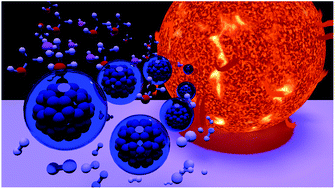Our official English website, www.x-mol.net, welcomes your
feedback! (Note: you will need to create a separate account there.)
A soft-chemistry assisted strong metal-support interaction on a designed plasmonic core-shell photocatalyst for enhanced photocatalytic hydrogen production.
Nanoscale ( IF 5.8 ) Pub Date : 2020/01/28 , DOI: 10.1039/c9nr09891g Getaneh Diress Gesesse 1 , Cong Wang , Bor Kae Chang , Shih-Hsuan Tai , Patricia Beaunier , Robert Wojcieszak , Hynd Remita , Christophe Colbeau-Justin , Mohamed Nawfal Ghazzal
Nanoscale ( IF 5.8 ) Pub Date : 2020/01/28 , DOI: 10.1039/c9nr09891g Getaneh Diress Gesesse 1 , Cong Wang , Bor Kae Chang , Shih-Hsuan Tai , Patricia Beaunier , Robert Wojcieszak , Hynd Remita , Christophe Colbeau-Justin , Mohamed Nawfal Ghazzal
Affiliation

|
Engineering photocatalysts based on gold nanoparticles (AuNPs) has attracted great attention for the solar energy conversion due to their multiple and unique properties. However, boosting the photocatalytic performance of plasmonic materials for H2 generation has some limitations. In this study, we propose a soft-chemistry method for the preparation of a strong metal-support interaction (SMSI) to enhance the photocatalytic production of H2. The TiO2 thin overlayer covering finely dispersed AuNPs (forming an SMSI) boosts the photocatalytic generation of hydrogen, compared to AuNPs deposited at the surface of TiO2 (labelled as a classical system). The pathway of the charge carriers' dynamics regarding the system configuration is found to be different. The photogenerated electrons are collected by AuNPs in a classical system and act as an active site, while, unconventionally, they are injected back in the titania surface for an SMSI photocatalyst making the system highly efficient. Additionally, the adsorption energy of methanol, theoretically estimated using the density functional theory (DFT) methodology, is lower for the soft-chemistry SMSI photocatalyst accelerating the kinetics of photocatalytic hydrogen production. The SMSI obtained by soft-chemistry is an original concept for highly efficient photocatalytic materials, where the photon-to-energy conversion remains a major challenge.
中文翻译:

软化学在设计的等离激元核-壳型光催化剂上辅助了强的金属-载体相互作用,从而增强了光催化氢的产生。
基于金纳米颗粒(AuNPs)的工程光催化剂由于具有多重和独特的性能而引起了太阳能转化的极大关注。但是,提高等离子体材料对H2生成的光催化性能有一定的局限性。在这项研究中,我们提出了一种软化学方法,用于制备强金属-载体相互作用(SMSI)以增强H2的光催化产生。与沉积在TiO2表面的AuNPs(标记为经典体系)相比,覆盖有精细分散的AuNPs(形成SMSI)的TiO2薄覆盖层促进了氢的光催化生成。发现关于系统配置的电荷载流子动力学的路径是不同的。光生电子由AuNPs在经典系统中收集并充当活性位点,而非常规地,它们被注入二氧化钛表面以用作SMSI光催化剂,从而使该系统高效。另外,理论上使用密度泛函理论(DFT)方法估计的甲醇吸附能,对于软化学SMSI光催化剂而言较低,从而加速了光催化制氢的动力学。通过软化学获得的SMSI是高效光催化材料的原始概念,其中光子到能量的转换仍然是主要挑战。使用密度泛函理论(DFT)方法进行理论估算,对于软化学SMSI光催化剂而言,该值较低,可加速光催化制氢的动力学。通过软化学获得的SMSI是高效光催化材料的原始概念,其中光子到能量的转换仍然是主要挑战。使用密度泛函理论(DFT)方法进行理论估算,对于软化学SMSI光催化剂而言,该值较低,可加速光催化制氢的动力学。通过软化学获得的SMSI是高效光催化材料的原始概念,其中光子到能量的转换仍然是主要挑战。
更新日期:2020-04-03
中文翻译:

软化学在设计的等离激元核-壳型光催化剂上辅助了强的金属-载体相互作用,从而增强了光催化氢的产生。
基于金纳米颗粒(AuNPs)的工程光催化剂由于具有多重和独特的性能而引起了太阳能转化的极大关注。但是,提高等离子体材料对H2生成的光催化性能有一定的局限性。在这项研究中,我们提出了一种软化学方法,用于制备强金属-载体相互作用(SMSI)以增强H2的光催化产生。与沉积在TiO2表面的AuNPs(标记为经典体系)相比,覆盖有精细分散的AuNPs(形成SMSI)的TiO2薄覆盖层促进了氢的光催化生成。发现关于系统配置的电荷载流子动力学的路径是不同的。光生电子由AuNPs在经典系统中收集并充当活性位点,而非常规地,它们被注入二氧化钛表面以用作SMSI光催化剂,从而使该系统高效。另外,理论上使用密度泛函理论(DFT)方法估计的甲醇吸附能,对于软化学SMSI光催化剂而言较低,从而加速了光催化制氢的动力学。通过软化学获得的SMSI是高效光催化材料的原始概念,其中光子到能量的转换仍然是主要挑战。使用密度泛函理论(DFT)方法进行理论估算,对于软化学SMSI光催化剂而言,该值较低,可加速光催化制氢的动力学。通过软化学获得的SMSI是高效光催化材料的原始概念,其中光子到能量的转换仍然是主要挑战。使用密度泛函理论(DFT)方法进行理论估算,对于软化学SMSI光催化剂而言,该值较低,可加速光催化制氢的动力学。通过软化学获得的SMSI是高效光催化材料的原始概念,其中光子到能量的转换仍然是主要挑战。











































 京公网安备 11010802027423号
京公网安备 11010802027423号